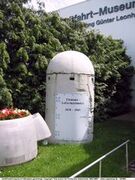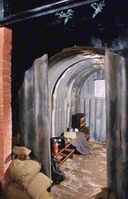Bomb Shelter

Bomb Shelters are structures, varying in size from hand-held to house-size, designed to keep bombs safe from harm. Typically constructed from extremely strong and durable materials in order to protect delicate munitions or other incendiary devices, they are most commonly used by bomb squads as a means of dealing with or transporting explosives in a safe and efficient manner. Any type of bomb can be placed safely in a bomb shelter of the proper strength: larger bombs require proportionally stronger shelters. Basements of sturdy buildings are often used as impromptu bomb shelters, since these tend to be centrally-located community buildings which many people can quickly arrive at and store their explosives.
History
In the 1860s, shortly after Alfred Nobel invented dynamite, people began blowing their dynamite and themselves up in great numbers. Due to constant misunderstandings and underestimates of the destructive power and physical characteristics of dynamite, many were carelessly handling the substance. For example, dynamite "sweats" pure nitroglycerin over time, resulting in an extremely dangerous situation which few people of the era were aware of. Another problem was the fact that a stick of dynamite will detonate if anyone in the immediate vicinity shouts “BOOM!”, which led to many harmless pranks turning into gruesome scenes.
Not wanting to be remembered as the man who caused the extinction of the human race by throwing into sharp relief both their curiosity and their vulnerability to explosions, Nobel began work on a new invention. Within a year he had perfected a small lead chamber which was capable of securing a small amount of dynamite. This primitive bomb shelter weighed over seventy tons and required forty horses to drag, rendering it virtually ineffective. Thus, people continued to dick around with dynamite and blow themselves up for another forty years, and Nobel was recorded in the annals of history as a merchant of death.
At the breakout of World War I, the need for a mobile bomb shelter became apparent when wave after wave of artillery munitions, explosives dumps, and fireworks caches were sabotaged by enemy forces,[1] causing the war to grind on without an end in sight. In a move that would run anti-parallel to their secret project in World War II, the Allies gathered together the brightest minds in their respective lands to develop an effective bomb defense strategy. Instead, they stole Nobel's design. In 1918 they perfected a roughly human-sized concrete shelter, capable of withstanding a two-megaton[2] blast from the artillery of attacking forces.[3] After manufacturing enough of the shelters to safely transport their explosives to the front lines, all that was necessary was to wait patiently on their side of the trenches and bombard the enemy's defenseless explosives; the war was over within nine days.
Various Models
There are many varieties of bomb shelter, reflecting the many different uses that the product boasts. Most are for commercial use, but there are several models designed specifically for the on-the-go demolitionist, pyromaniac, or terrorist.
Convenient Hand-Held Bomb Shelters
The cheapest and least effective kind of bomb shelter is the handy ‘mini-shelter’. While appearing to be a purse (or ‘murse’ if carried by a man), these unisex handbags will protect the owner's explosives from harm, while keeping said owner ‘snazzy’ and ‘sharp’. With a large variety of sizes and styles, these snappy accessories have become fashionable to carry even when only carrying such easily replaceable explosives as firecrackers or a soda & pop-rocks combination. Typical middle-class families have one such shelter for safekeeping their collective explosives, similar to how said family usually has a safe for money and a basement or attic for the middle child. The hand-held bomb shelter is the protection of choice for terrorists, as suicide bombers often find themselves accosted before their target is reached.[4]
Larger Bomb Shelters
For storage of large quantities of explosives, standard-sized bomb shelters are typically employed. These can range in size anywhere from just a meter tall to massive underground bunkers. Hoards of ammunition and other explosive materials were stored this way during World War I by the Allied forces (see History section of this article). It was common practice during this time for so-called ‘air raid sirens’ to be sounded in Allied communities, signifying a daring aerial attack.[5] In such an event, families would rush to their bomb shelters, secure their dynamite and other incendiaries, lock the shelter, and hide under trees or rocks so as not to be blown up themselves.
In more recent times, bomb shelters have been used to protect bombs from possible global catastrophe. Doomsday nutjobs have stockpiled huge amounts of explosives in personal bomb shelters, convinced the end of the world is upon us. These rational individuals have cited reasons for their fear including Y2K, nuclear warfare, zombie infestation, and American Idol. The general public has largely ignored these pleas for attention, and the government is allowing cases of explosive-hoarding as long as proper bomb shelter-building procedures are observed.
Ridiculously Enormous Bomb Shelters
It has been suggested that a bomb shelter large enough to contain an entire country could be constructed, given the resources and manpower. A project of this size would far surpass any construction undertaking in the history of mankind, including The Great Pyramids at Giza, The Great Wall of China, and the flooding of the state of Florida. Countries could render their entire stockpile of explosives immune from attack or sabotage. However, the cost of such an operation would be astronomical. The massive amount of concrete needed for such a structure would deplete all of the resources on Earth, and the concrete-rich valleys of the Moon would need to be mined. Also, such a brazenly large structure would cut off its inhabitants of critical things such as sunlight, air, and having neighboring countries to hate on so as to feel better about themselves.
References
- ↑ The Good Guys™ (if you're German), or the Germans (if you're anyone else)
- ↑ Explosions are typically measured in ‘megatons’, with one megaton being the amount of dynamite necessary to produce 1,674 foot-pounds of torque on a 35-foot wooden wheel that is being pulled in another direction by seven horses.
- ↑ Germans, probably
- ↑ Though not if snappily dressed
- ↑ By the Germans and their Air Force, known as the Luftwaffle
| Featured version: 16 February 2009 | |
| This article has been featured on the main page. — You can vote for or nominate your favourite articles at Uncyclopedia:VFH. | |



